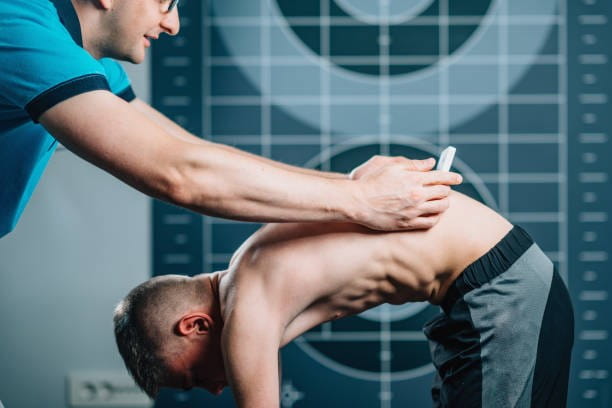Scoliosis happens when the spine grows with an abnormal, side-to-side curve. We call scoliosis by different names. The name depends on the age when it is diagnosed:
- Adolescent idiopathic scoliosis – diagnosed at age 10 and older
- Early onset scoliosis (EOS), including:
- Congenital scoliosis – diagnosed at birth or shortly after birth
- Infantile idiopathic scoliosis – diagnosed under age 5
- Juvenile idiopathic scoliosis – diagnosed between ages 6 and 9
In pre-teens and teens with scoliosis, the spine doesn’t grow straight. Instead, it curves as it grows.
This usually happens in an “S” or “C” shape. Sometimes it also twists as it grows.
Spinal curves range from mild to severe. They are measured in degrees.
- Mild: Less than 20 degrees
- Moderate: Between 25 degrees and 40 degrees
- Severe: More than 50 degrees

Sometimes, the spinal curve will be stable. This means it will not change much over time. In other cases, the curve is progressive. This means it gets worse over time.
Adolescent idiopathic scoliosis affects girls more often than boys.
Spinal curves often develop during a growth spurt in the early teen years.
Adolescent Scoliosis Causes
The word idiopathic means having no known cause. In most cases, the cause of adolescent scoliosis is unknown. That’s why this diagnosis is most often called adolescent idiopathic scoliosis.
Research is being done to look into how and why scoliosis develops. About 30% of patients with AIS show some family history of scoliosis. The cause may include a mix of genetic and environmental factors.
Adolescent Scoliosis Signs and Symptoms
Symptoms of scoliosis are different from person to person. Symptoms can include a difference in any of the following:
- Shoulder height
- Head position (the head is not centered with the rest of the body)
- Hip height or position
- Shoulder blade height or position
- The way the arms hang beside the body when standing straight
- The way the sides of the back look when bending forward
You or your child may also notice that their clothes aren’t hanging straight.
Most teens with scoliosis do not have pain because of it.
Adolescent Scoliosis Diagnosis
Most of the time, adolescent scoliosis is found during a routine physical exam.
When you come to the Crawford Spine Center at Cincinnati Children’s, you can expect our team of experts to:
- Perform a complete evaluation of your child
- Review your child's medical history
- Perform needed tests to see if the bones have any problems
- Measure the degree of your child’s spinal curve
- Order X-rays to figure out the exact angles of the curve
X-rays are the main test for AIS. The doctor may have additional tests done to gather more information. This could include MRI, ultrasound and/or CT scan.
The earlier scoliosis is diagnosed, the better. That means treatment can start sooner. Starting treatment as soon as possible offers the best long-term results.
Adolescent Scoliosis Treatment
Treatment for adolescent scoliosis depends on the size of your child’s spinal curve and how severe it is. The Crawford Spine Center offers both surgical and non-surgical options. Many of the least invasive techniques we offer were created by our doctors using the latest technology.
The goals of treatment are:
- To slow the curve’s progression
- Correct the curve
- Prevent related health issues
- Prevent or delay the need for surgery.
Our treatment plans are custom-made for each patient. Your child’s treatment may include any of the following:
- Monitoring (watch and wait)
- Your child will have routine X-rays so the doctor can watch for changes in the degree of the curve
- Often done with more mild curves
- Bracing (Thoracic Lumbar Sacral Orthosis/TLSO braces)
- Controls the progress of scoliosis while a child is still growing
- Made of hard plastic
-
Can be put on and taken off at home as needed
- Some are designed to be worn up to 23 hours a day; others are worn overnight
- Common for mild to moderate curves
- Spinal fusion surgery including minimally invasive options
- Allows two or more bones in the spine (vertebrae) to grow together (fuse) into one solid bone so the spine cannot bend
- Helps the spine grow in a straighter position
- Can help with back pain
- More often used in older children and teens
- Non-fusion surgery
Long-Term Outcomes
If scoliosis is not treated, it can lead to very severe deformities. It can also cause serious respiratory (breathing) problems.
The long-term outcome depends on the degree of your child’s curve. Those with small to moderate curves tend to do well with treatment. Those with moderate curves in their lower back may have slightly more back pain. For patients with larger curves, long-term outcomes following surgery are excellent.
Those who are treated for other disorders, in addition to the spinal deformity, may need long-term care into adulthood.




